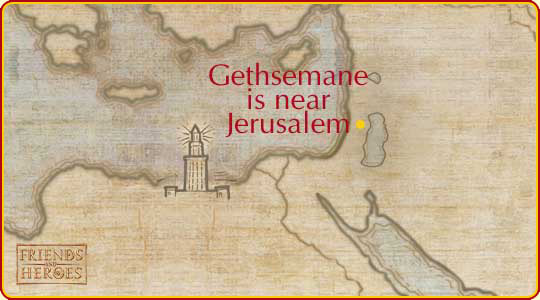|
Gethsemane, or Gat Shmaním, which means “oil press”, was a garden at the foot of the Mount of Olives. The garden is only mentioned by name in the Gospels of Matthew and Mark, which both describe the same scene, commonly known as the Agony in the Garden.
The Agony in the Garden took place on the night of Jesus’ arrest. After the famous Last Supper, “Jesus went with his disciples to a place called Gethsemane, and he said to them, ‘Sit here while I go over there and pray.’” (Matthew 26:36) Whilst Jesus was praying, the disciples fell asleep. Three times Jesus asked his disciples to sit and pray, and each time they fell asleep. Jesus’ prayers were almost like pleas, asking God to “Take this cup from me.” Jesus knew, of course, the events to follow were part of God’s big plan. “Yet not what I will, but what you will.” Mark 14:36 The Mount of Olives, and therefore Gethsemane, was a place Jesus and his Disciples visited regularly. Going there to pray was nothing unusual, however, it meant Judas was able to easily find Jesus to have him arrested. Gethsemane’s location is uncertain and there are at least four places near the foot of the mountain that claim to be the true garden. Each claim was made by a different Christian denomination: Catholic, Eastern Christianity, Greek Orthodox and Russian Orthodox. The first claim is the garden at the Catholic Church of All Nations in Jerusalem. The church, which was consecrated in 1924, is built on the remains of a 12th-century Crusader chapel, which in turn had been erected on the site of a 4th-century Byzantine basilica. Enshrined within the church is a piece of bedrock claiming to be where Jesus prayed before his arrest. The second location claiming to be Gethsemane is near the Church of the Sepulchre of Saint Mary, which is where Eastern Christians believe Mary, the mother of Jesus was buried. According to tradition, Mary died a natural death and was buried in the tomb, however, was resurrected three days later. Following this, Mary was taken up to heaven in bodily form, which is known as the Assumption of Mary. The Greek Orthodox Church has supposedly determined Gethsemane would have been on the east side of the Mount of Olives, however, has expressed no precise location. The Russian Orthodox Church, on the other hand, is certain Gethsemane is the orchard next to the Church of Mary Magdalene. The Russian architect David Grimm designed the church for Tsar Alexander III who wished to honour his mother, Empress Maria Alexandrovna. A relic of the martyred saint Grand Duchess Elizabeth Feodorovna of Russia, who was murdered by the Bolsheviks in 1918, can be found in the church, alongside a relic of the nun Varvara Yakovleva who was also murdered along with the royal family. Having expressed the wish to be buried near her grandmother, Princess Alice of Battenberg, the mother of Princess Phillip, was buried in the crypt below the church. It is impossible to determine which, if any, of the claimants are the true location of Gethsemane, however, they are all within proximity of each other. Olive trees in the area have been determined to be the oldest known to science, however, it is uncertain whether they would have been the same trees that Jesus was familiar with. Carbon dating has placed some of the trees as far back as 1092. Since olive trees can regrow from their roots if chopped down, there is a very strong chance that these trees have been there since biblical times. Just for fun, I have found out some facts about olives:
0 Comments
Your comment will be posted after it is approved.
Leave a Reply. |
©Copyright
We are happy for you to use any material found here, however, please acknowledge the source: www.gantshillurc.co.uk AuthorRev'd Martin Wheadon Archives
June 2024
Categories
All
|

 RSS Feed
RSS Feed